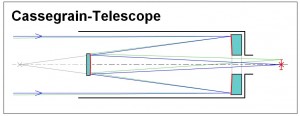Cassegrains are reflectors. The classic Cassegrain has a parabolic (concave) primary mirror and a hyperbolic (convex) secondary mirror. As you can see from the diagram below, the mirrors are aligned with the focal point behind the primary mirror (outside the telescope tube, at the end of the tube). The light is gathered through the open end of the tube on the left and bounced off the primary mirror onto the secondary mirror. The secondary mirror then bounces the light to the central focal point, through a hole in the primary mirror at the right.
After some searching, I found the original description of the Cassegrain telescope in the 29 February 1672 issue of the Journal des Sçavans.* Here’s the .pdf, Cassegrain Telescope, 1672 Journal of Sçavans, courtesy of Gallica Bibliothèque Numérique.
